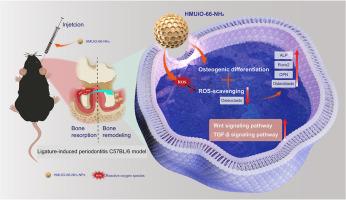Bifunctional mesoporous HMUiO-66-NH2 nanoparticles for bone remodeling and ROS scavenging in periodontitis therapy
IF 12.9
1区 医学
Q1 ENGINEERING, BIOMEDICAL
引用次数: 0
Abstract
Periodontal bone defects represent an irreversible consequence of periodontitis associated with reactive oxygen species (ROS). However, indiscriminate removal of ROS proves to be counterproductive for tissue repair and insufficient for addressing existing bone defects. In the treatment of periodontitis, it is crucial to rationally alleviate local ROS while simultaneously promoting bone regeneration. In this study, Zr-based large-pore hierarchical mesoporous metal-organic framework (MOF) nanoparticles (NPs) HMUiO-66-NH2 were successfully proposed as bifunctional nanomaterials for bone regeneration and ROS scavenging in periodontitis therapy. HMUiO-66-NH2 NPs demonstrated outstanding biocompatibility both in vitro and in vivo. Significantly, these NPs enhanced the osteogenic differentiation of bone mesenchymal stem cells (BMSCs) under normal and high ROS conditions, upregulating osteogenic gene expression and mitigating oxidative stress. Furthermore, in vivo imaging revealed a gradual degradation of HMUiO-66-NH2 NPs in periodontal tissues. Local injection of HMUiO-66-NH2 effectively reduced bone defects and ROS levels in periodontitis-induced C57BL/6 mice. RNA sequencing highlighted that differentially expressed genes (DEGs) are predominantly involved in bone tissue development, with notable upregulation in Wnt and TGF-β signaling pathways. In conclusion, HMUiO-66-NH2 exhibits dual functionality in alleviating oxidative stress and promoting bone repair, positioning it as an effective strategy against bone resorption in oxidative stress-related periodontitis.

双功能介孔 HMUiO-66-NH2 纳米粒子在牙周炎治疗中用于骨重塑和清除 ROS。
牙周骨缺损是牙周炎与活性氧(ROS)相关的不可逆转的后果。然而,不加区分地清除 ROS 对组织修复适得其反,而且不足以解决现有的骨缺损问题。在牙周炎的治疗中,合理缓解局部 ROS 的同时促进骨再生至关重要。本研究成功地提出了基于锆的大孔分层介孔金属有机框架(MOF)纳米粒子(NPs)HMUiO-66-NH2,作为骨再生和清除ROS的双功能纳米材料用于牙周炎的治疗。HMUiO-66-NH2 NPs 在体外和体内都表现出卓越的生物相容性。值得注意的是,这些 NPs 增强了骨间充质干细胞(BMSCs)在正常和高 ROS 条件下的成骨分化,上调了成骨基因表达并减轻了氧化应激。此外,体内成像显示 HMUiO-66-NH2 NPs 在牙周组织中逐渐降解。局部注射 HMUiO-66-NH2 能有效减少牙周炎诱导的 C57BL/6 小鼠的骨缺损和 ROS 水平。RNA 测序结果表明,差异表达基因(DEGs)主要参与骨组织发育,其中 Wnt 和 TGF-β 信号通路显著上调。总之,HMUiO-66-NH2 具有缓解氧化应激和促进骨修复的双重功能,可作为一种有效的策略,防止氧化应激相关牙周炎引起的骨吸收。
本文章由计算机程序翻译,如有差异,请以英文原文为准。
求助全文
约1分钟内获得全文
求助全文
来源期刊

Biomaterials
工程技术-材料科学:生物材料
CiteScore
26.00
自引率
2.90%
发文量
565
审稿时长
46 days
期刊介绍:
Biomaterials is an international journal covering the science and clinical application of biomaterials. A biomaterial is now defined as a substance that has been engineered to take a form which, alone or as part of a complex system, is used to direct, by control of interactions with components of living systems, the course of any therapeutic or diagnostic procedure. It is the aim of the journal to provide a peer-reviewed forum for the publication of original papers and authoritative review and opinion papers dealing with the most important issues facing the use of biomaterials in clinical practice. The scope of the journal covers the wide range of physical, biological and chemical sciences that underpin the design of biomaterials and the clinical disciplines in which they are used. These sciences include polymer synthesis and characterization, drug and gene vector design, the biology of the host response, immunology and toxicology and self assembly at the nanoscale. Clinical applications include the therapies of medical technology and regenerative medicine in all clinical disciplines, and diagnostic systems that reply on innovative contrast and sensing agents. The journal is relevant to areas such as cancer diagnosis and therapy, implantable devices, drug delivery systems, gene vectors, bionanotechnology and tissue engineering.
 求助内容:
求助内容: 应助结果提醒方式:
应助结果提醒方式:


